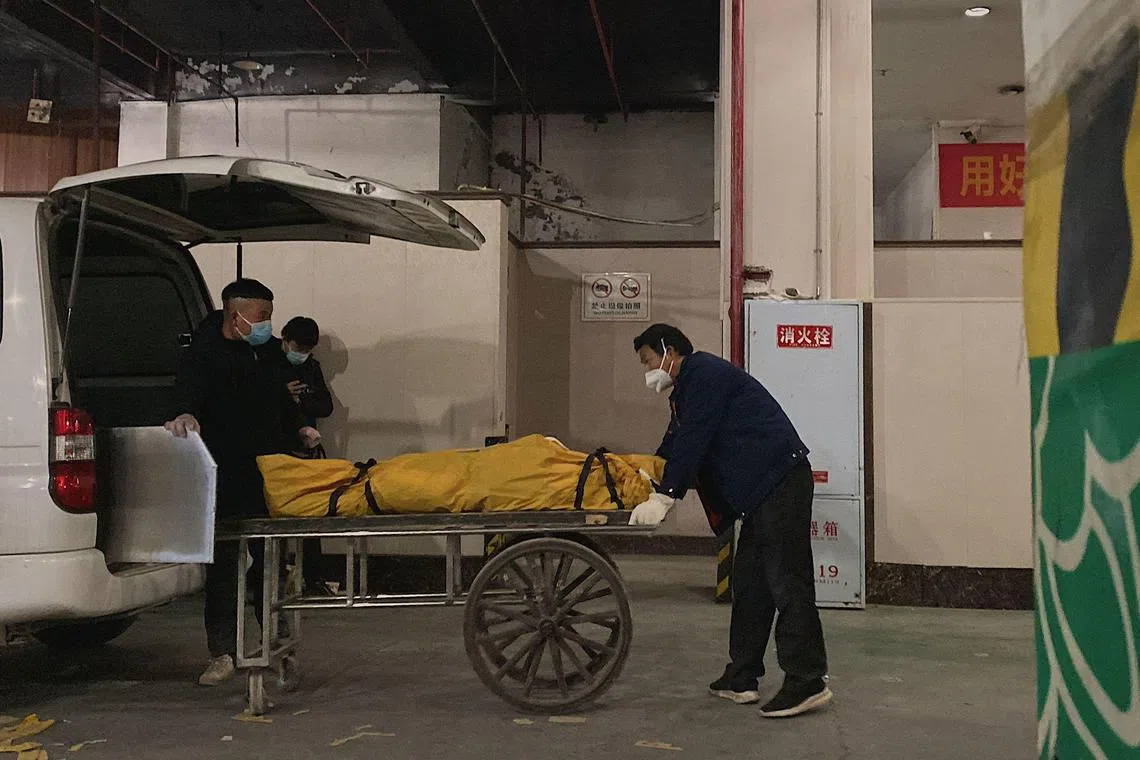China’s Covid-19 death toll at 60,000 in a month, says health authority
Sign up now: Get insights on Asia's fast-moving developments

Medical institutions in China recorded 59,938 deaths between Dec 8 and Jan 12 caused by Covid-19.
PHOTO: AFP
Follow topic:
BEIJING - For the first time since China abandoned its zero-Covid policy in early December,
At a press conference by the National Health Commission on Saturday, its chief of medical policy Jiao Yahui said hospitals and medical institutions nationwide recorded 59,938 deaths between Dec 8, 2022, and Jan 12, 2023, caused by Covid-19. Among them, 5,503 died from respiratory failure and 54,435 died of complications from underlying diseases.
It is not known if Covid-19-related deaths that occurred outside hospitals were included in the tally. Crematoriums across the country have been overburdened, while grieving families have taken to social media to complain about long lines.
The health authority stopped publishing daily figures on Dec 25, after the statistics were said to be meaningless, as mass testing was scrapped and mandatory quarantine and treatment were no longer required for those who were infected.
But it had also come under criticism for not being transparent with its data and under-reporting the number of deaths.
Health officials also recently explained that they would count a Covid-19 death only if the virus had caused respiratory failure.
The World Health Organisation (WHO) on Wednesday appealed to China for more information about its Covid-19 outbreak, such as hospitalisation numbers, virus sequencing, as well as the comparative death rates between urban and rural areas.
“WHO still believes that deaths are heavily under-reported from China, and this is in relation to the definitions that are used but also to the need for doctors and those reporting in the public health system to be encouraged to report these cases and not discouraged,” said Dr Mike Ryan, the head of health emergencies at the United Nations agency.
The average age of the nearly 60,000 people who died was 80.3 years old, and 90.1 per cent were over the age of 65, while 56.5 per cent were aged 80 and above.
The number of people seeking treatment at hospitals has also been trending downwards, including in rural areas, indicating that the infection peak is over, said Ms Jiao. For instance, as many as 2.867 million went to a fever clinic on Dec 23 but just 477,000 by Jan 12.
Those who sought emergency treatment at hospitals reached a high of 1.526 million on Jan 2, before falling to 1.092 million by Jan 12.
And while the number of people who were hospitalised for Covid-19 has also fallen from a peak of 1.625 million on Jan 5 to 1.27 million on Jan 12, the number of severe cases remains high, said Ms Jiao.
Those seriously ill reached 128,000 on Jan 5, tapering off to 105,000 by Jan 12. Still, that has not overwhelmed critical care facilities, said Ms Jiao, who added that the utilisation rate of intensive care unit (ICU) beds was 75.3 per cent.
Local governments say they have crossed the peak in infections. The Henan Health Commission on Monday noted that 89 per cent of the central province’s 99 million population have already contracted Covid-19.
Beijing’s acting mayor Yin Yong also told state media last week that the tsunami of infections that swept the capital city in December is over, which has helped to build immunity in the community. It will now monitor the emergence of new variants and minimise the disruption.
Chinese experts have now projected a second wave of infections to peak between May and June. Shanghai infectious disease specialist Zhang Wenhong predicted that 25 to 50 per cent of people may be infected, although their symptoms may be milder.


